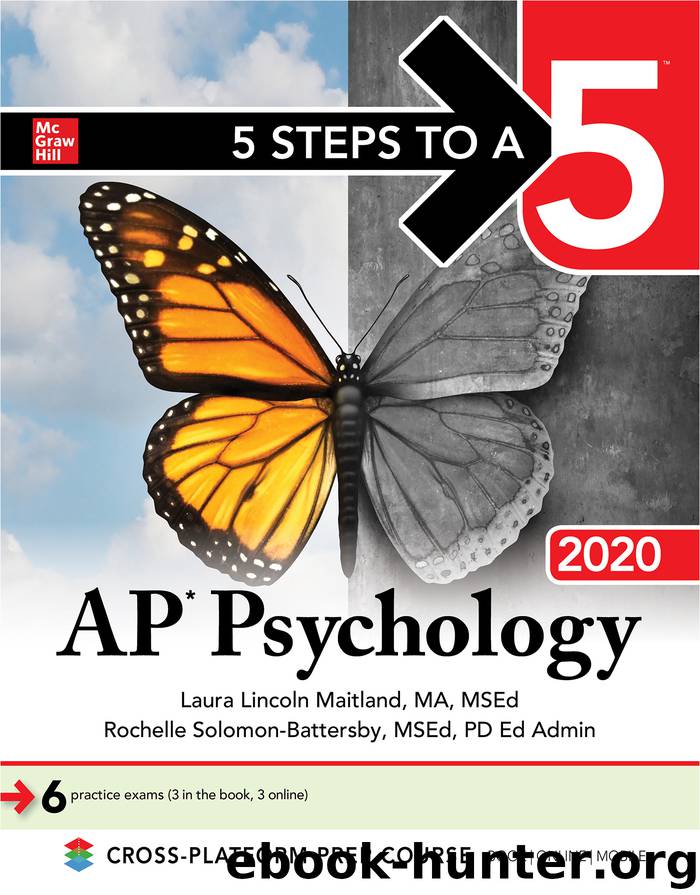5 Steps to a 5: AP Psychology 2020 by Laura Lincoln Maitland

Author:Laura Lincoln Maitland
Language: eng
Format: epub
Publisher: McGraw-Hill Education
Published: 2019-08-02T16:00:00+00:00
Erikson’s Stage Theory of Psychosocial Development
Parents are not the only people who interact with children; each stage of development requires a new level of social interaction. Starting with kindergarten, frequent peer interactions become more complex and structured and lead to friendships. Peer interactions help children develop social skills such as cooperation, empathy, and self-regulation. Erik Erikson was an influential theorist partly because he examined development across the life span in a social context, rather than just during childhood, recognizing that we continue to grow beyond our teenage years, and our growth is influenced by others. His stage theory of psychosocial development identifies eight stages during which we face an important issue or crisis. How we resolve each crisis shapes our personality and affects our relationships with others.
• Stage One: Infants (newborn to 1 year old) face the crisis of trust vs. mistrust. Parents must provide a safe, consistent, and loving environment for children to leave this stage healthily with a strong trust that others care and will always be there for them. Mistrust, based on inconsistent, cold, or abusive situations, prevents children from leaving this stage ready to form lasting and close relationships in the future.
• Stage Two: Toddlers (2 years old) face the crisis of autonomy vs. shame and doubt. The nickname “terrible twos” comes from children’s needs to develop self-control and do things for themselves, which can often result in spills, falls, wetting, and other accidents. Children who are encouraged to try new skills develop autonomy, while those who are ridiculed or overprotected may doubt their abilities and feel ashamed of their actions.
• Stage Three: Children (3–5 years of age) face the crisis of initiative vs. guilt. Children need to learn to make plans and carry out tasks through play, asking questions, making choices, and using their imaginations to develop initiative. If they are severely criticized, discouraged from asking questions, not permitted to make choices, or prevented from playing, children feel guilty.
• Stage Four: School-aged children (6–12 years of age) face the crisis of industry vs. inferiority. Children need to be positively reinforced for productive activities, such as achieving in the classroom, on the sports field, or artistically or musically, in order to develop a healthy self-concept and a sense of industry. If children’s efforts are considered inadequate, feelings of social or mental inferiority in this stage can carry over to a poor self-concept in the future.
• Stage Five: The crisis of stage five for adolescents (about 12–20 years of age) is identity vs. role confusion. Answering the question, “Who am I?” is the major task, which involves building a consistent identity, a unified sense of self. During adolescence, peer relationships become much more important. Because family and peer groups often have different values, attitudes, beliefs, and perspectives, adolescents are faced with opportunities and challenges to define themselves. Failure of teens to achieve a sense of identity results in role confusion and uncertainty about who they are and where they are going.
• Stage Six: Young adults (about 21–40 years of age) face the crisis of intimacy vs.
Download
This site does not store any files on its server. We only index and link to content provided by other sites. Please contact the content providers to delete copyright contents if any and email us, we'll remove relevant links or contents immediately.
Barron's AP Biology by Goldberg M.S. Deborah T(4099)
ACT Math For Dummies by Zegarelli Mark(3996)
What It Really Takes to Get Into Ivy League and Other Highly Selective Colleges by Hughes Chuck(3697)
5 Steps to a 5 AP U.S. History, 2010-2011 Edition (5 Steps to a 5 on the Advanced Placement Examinations Series) by Armstrong Stephen(3689)
McGraw-Hill's SAT 2014 Edition (Mcgraw Hill's Sat) by Black Christopher & Anestis Mark(3391)
Kick Ass in College: Highest Rated "How to Study in College" Book | 77 Ninja Study Skills Tips and Career Strategies | Motivational for College Students: A Guerrilla Guide to College Success by Fox Gunnar(3076)
Graduate Admissions Essays, Fourth Edition: Write Your Way into the Graduate School of Your Choice (Graduate Admissions Essays: Write Your Way Into the) by Asher Donald(2876)
Get into Any College by Tanabe Gen Tanabe Kelly(2686)
Easy Algebra Step-by-Step by Sandra Luna McCune(2585)
500 Must-Know AP Microeconomics/Macroeconomics Questions(2532)
The Official Guide to the TOEFL Test by ETS(2288)
Cracking the Sat French Subject Test, 2013-2014 Edition by The Princeton Review(1829)
Open the Gates to the Ivy League: A Plan B for Getting into the Top Colleges by C. W. Henderson(1799)
Barron's AP Calculus by David Bock(1779)
Law School Essays that Made a Difference by Princeton Review(1761)
Cracking the SAT Literature Subject Test, 2013-2014 Edition (College Test Preparation) by Princeton Review(1724)
Barron's SAT Math Workbook by Lawrence S. Leff(1701)
Cracking the AP Physics C Exam, 2018 Edition by Princeton Review(1683)
ASVAB AFQT For Dummies by Rod Powers(1621)
